Beyond Aero – Things to Think About when Buying a New Tri Bike
We get it (and have preached it for years). Sustainable full-vehicle (bike and rider) aerodynamics is really important for triathletes looking to maximize their performance. This being said, there are a lot of aero tri bikes on the market. Making a decision based on one being slightly more aero than another in a wind tunnel test can be short-sighted. At some point, you need to think beyond aero and consider the total ownership experience of your new tri bike. We published an article about our top tri bike recommendations for ’18 recently. This article talks about things beyond aerodynamics that should also be considered when buying a new tri bike.
Proprietary Parts
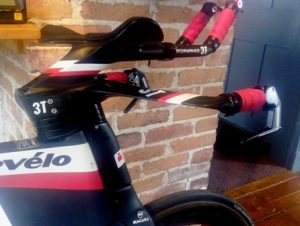
From stem to stern, some of the “superbikes” have a host of proprietary parts and integrated designs. While there is nothing inherently wrong with proprietary parts and integrated designs, some work better than others and all are proprietary and thus not readily available everywhere. Especially if you travel regularly with your bike, it is helpful to know what you are getting into with your bike in terms of proprietary items so that you can either make a decision on a bike that has relatively few of them or you can make sure you have an adequate plan for having spares on-hand if something is lost or breaks. Having a discussion about the pluses and considerations of the proprietary parts on a new bike that you are considering can help you figure out what proprietary parts will work for you and which may prove frustrating.
Fit & Ease of Adjustability
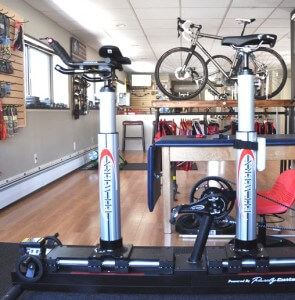 The biggest aerodynamic variable on a tri bike is you – the rider. This means that your riding position, in combination with your technique and physical development, are crucial to you being able to sustain as efficient and low drag position as possible when riding. The bottom line is that you should be fit before you buy your new tri bike and you shouldn’t even consider any bike that does not support your riding position well now and offers adjustability for the future as well. We’ve worked with numerous people who bought the most aero bike they thought they could, only to find out that it was scary to ride or simply couldn’t achieve a reasonable riding position for their needs safely. There are a lot of good tri bikes on the market. There is no reason to compromise on this crucial variable.
The biggest aerodynamic variable on a tri bike is you – the rider. This means that your riding position, in combination with your technique and physical development, are crucial to you being able to sustain as efficient and low drag position as possible when riding. The bottom line is that you should be fit before you buy your new tri bike and you shouldn’t even consider any bike that does not support your riding position well now and offers adjustability for the future as well. We’ve worked with numerous people who bought the most aero bike they thought they could, only to find out that it was scary to ride or simply couldn’t achieve a reasonable riding position for their needs safely. There are a lot of good tri bikes on the market. There is no reason to compromise on this crucial variable.
Some bikes, like the Cervelo P5X, are a relative joy as a fitter to work with. Others, like the Cervelo P5 and Trek Speed Concept, not so much… You can tell when a designer thought about the user experience when it comes to position and set-up on a tri bike and when it was secondary. If your riding position is well established and unlikely to change, this may not matter much at all to you. However, if you want to be able to change your position as you develop as a rider (or aero field test easily with your power meter to find out what is optimal) it is a boon to have a bike that you can adjust in a reasonable amount of time.
Travel and Ease of Packing
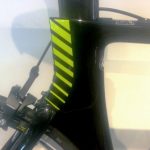
I’ll get it out of the way – packing tri bikes for travel is not something people tend to do for pleasure. Even the easiest and best designed tri bikes take time and thought to pack, while the most challenging can feel more demanding to pack and unpack than the actual Ironman that they are often travelling to race. If you do local/regional races that you drive to, ease of packing may have no value to you whatsoever. On the other hand, if you travel far enough for races to get on a plane, ease of packing and unpacking can have significant value.
The most well thought out tri bike we have seen to date when it comes to travel and ease of packing is the Cervelo P5X. Packing was definitely not an afterthought as the P5X comes with its own integrated travel case and the aerobars are designed to fold up on themselves with the removal of a few bolts. It takes a little practice initially to learn where things go, but packing a Cervelo P5X is as good as it gets when it comes to packing and travel ease. This being said, the P5X is not an entry level bike and is priced accordingly.
In general, bikes that have mechanically simpler aerobar systems (read: non-integrated) and straight-forward cabling and braking systems are easier to package than bikes with heavily concealed brakes and cables. SRAM eTap equipped bikes can sometimes be easier to pack than some other options as they don’t have any shift cables or wires behind the aerobar. Of course, the bigger your bike, the more challenging it can be to fit it all into a travel box. Outside of a P5X with its co-designed bag, we’ve yet to find a solution for this problem.
Storage Options
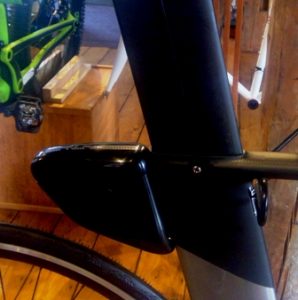
Integrated storage solutions are all the rage on tri bikes in recent years. Being comfortable with the storage options (and their capacity) for the things you need/use most on your new bike can be of value. Some bikes are vast caverns of integrated storage space while others are more minimal. In other cases, like Cervelo’s P2 and P3 bikes, there is basically no integrated storage from the factory, but there are some nice design details that allow a host of aftermarket hydration and storage systems to be easily bolted on. While well-executed integrated storage can work really well, it can also fall under the realm of “proprietary” and thus you may not have any options if you are not happy with its function, quality or shape.
Why You May Want to Buy a Tri Bike That Has Been On the Market for a Year or More
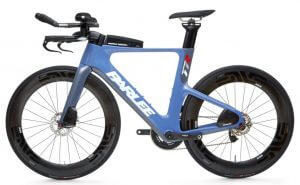 Have you ever glared at your brand new cell phone or computer as the thought, “My old phone didn’t have this problem?” pierces your brain?
Have you ever glared at your brand new cell phone or computer as the thought, “My old phone didn’t have this problem?” pierces your brain?
Don’t get us wrong, new product can be a lot of fun. Some of it even works really well. However, there are a number of examples where second generation product becomes a fair amount more user friendly after some production and design glitches are revised and smoothed out a bit. While not being as trendy as “the bike of the month”, Version 1.1 (or 1.2, 1.3…) of a well designed bike can often be just as potent aerodynamically while being more polished and more enjoyable to live with. A good example of this is the venerable Cervelo P3 and P2. A couple years into the current generation, they remain benchmark bikes that all others are judged aerodynamically. Yet, they are also very “finished products” that are mechanically straight-forward, with few proprietary parts and offering great compatibility with a number of aftermarket accessories. If you don’t achieve your goals, you’d have a very steep uphill argument to blame buying a P2/P3 instead of a competitor. The P3 and P2 don’t chase trends. They simply work and remain some of the most potent and proven bikes year after year.
When it comes to integrated “superbike” designs, the Cervelo P5X is the most polished and “finished” superbike design we have encountered to date. Likewise, Felt’s IA design may be a few years old, but has had numerous little items (brakes, storage, aerobars) improved over the years and is a polished package that is available starting below $3000. I would gladly compare a P5X or Felt IA to any of ’18’s designs and argue that they are better bikes for the majority of athletes. Would you rather be working on your bike or riding it?
Contact us for information on some of the best tri bikes on the market for ’18.

